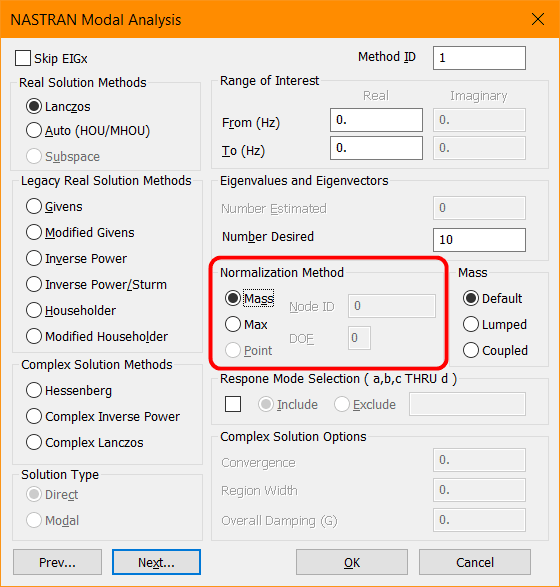Hello!,
Although the scaling of normal modes is arbitrary, for practical considerations mode shapes should be scaled (i.e., normalized) by a chosen convention. In
FEMAP & Simcenter Nastran we have four normalization choices: MASS, MAX, AF, and POINT normalization.
•
MASS normalization is the default method of eigenvector normalization, scaling each eigenvector to result in a unit value of generalized mass.
•
MAX normalizes to the largest component of mass in analysis set, and
•
POINT normalizes to mass at a specific nodal degree of freedom. When using Point, you must also specify a node ID and degree of freedom.
Numerically the
MASS method results in a modal mass matrix that is an identity matrix. This normalization approach is appropriate for modal dynamic response calculations because it simplifies both computational and data storage requirements. When mass normalization is used with a model of a heavy, massive structure, the magnitude of each of the terms of the eigenvectors is very small.
Although mode shapes are relative quantities, a number of modal quantities can be helpful in predicting qualitative responses or in isolating troublesome modal frequencies. Since relative strains, internal loads, and stresses develop when a structure deforms in a mode shape, you may recover these quantities during a normal modes analyses. Basically, any quantity that you can recover for static analysis is also available for normal modes analysis.
In any case, it is important to remember that all the above output quantities are based on the relative displacements of a mode shape. The output quantities can be compared for a given mode, but not necessarily from one mode to another. However, they can still be effectively used in the analysis/design process.
Modal quantities can be used to identify problem areas by indicating the more highly stressed elements. Elements that are consistently highly stressed across many or all modes will probably be highly stressed when dynamic loads are applied.
Best regards,
Blas.
~~~~~~~~~~~~~~~~~~~~~~
Blas Molero Hidalgo
Ingeniero Industrial
Director
IBERISA
48004 BILBAO (SPAIN)
WEB:
Blog de FEMAP & NX Nastran:

